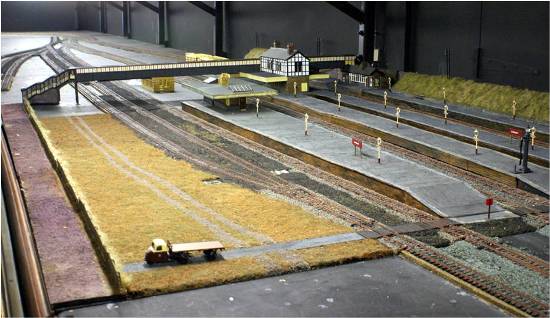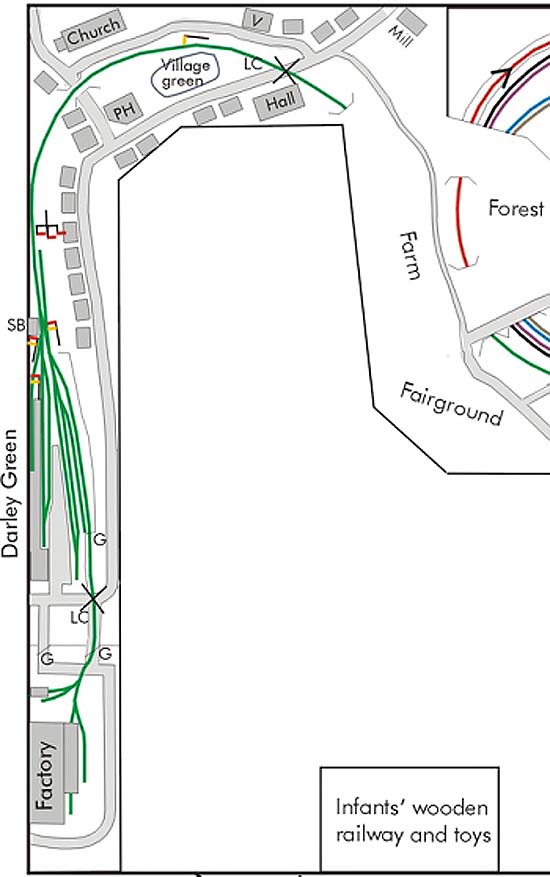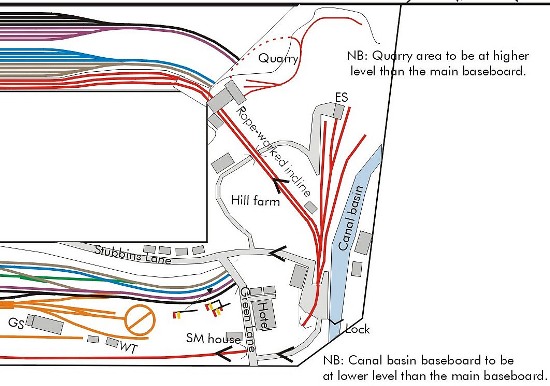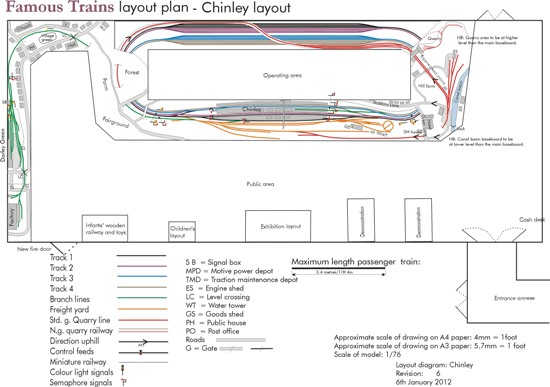The Layout
The Chinley layout
In 2010 our charity was most fortunate to be given a ready-made 00-scale layout that was remarkably close to the layout plan we had already devised. Based on Chinley station, Derbyshire, in the 1950s and 1960s, it is relevant to Derby railway history being on the former Midland Railway which was centred on Derby. The layout in its specially-built room in its former owner’s house measured about 40ft by 20ft. It is a pretty good fit in the designated building in Markeaton Park, and there is room for extensions to be added to enhance the interest to onlookers.


The layout has four main circuits with a loop in the station and a short bay platform for local trains. The four tracks run round to the back of the layout where there are four “hidden” loops on each track, enabling at least four trains to be run in sequence on each track. The loops are long enough to accommodate two trains of medium length, so even more trains will be run in the future. The station layout and pointwork reflect the scene at Chinley in the 1950s before BR’s first rationalisation around 1968.
The layout was designed by its owner to be viewed from the inside.
Members of Famous Trains model railway dismantled the layout in July 2010 and put it into secure storage. In November 2013 members moved the layout into the model railway building and made significant changes to it to suit its new location and purpose.
Changes to the layout
The most fundamental change was turning the front section round by 180 degrees so that it can be viewed from the outside. The ground level in the model rises from front to back, so this change was essential. We have added about 50cm to the new front edge of the layout so that we can include all the goods yard tracks. We have also completely rebuilt the back loops, and the curves to them at each end of the layout.
There are four main line tracks through the station. The Hope Valley Line tracks link Manchester via New Mills through Chinley and on to Sheffield. The Main Line tracks linked Manchester Central via the Disley tunnel through Chinley towards Matlock, Derby and London St. Pancras. Junctions (both west and east of Chinley) linked the Hope Valley and Main Lines so that trains could cross from one to the other. These are outside the limit of the layout, though there were slow-speed connections within the station area as well which are replicated on the layout. Buxton line trains would leave Chinley via the Main Line. Stone trains from the Peak Forest and Buxton area quarries would normally come through on the Main Lines while trains to the Earls cement works at Hope and coal trains from Yorkshire would use the Hope Valley lines.
Extensions
Branch line and Darley Green village
We are in the process of adding extensions of considerable interest. At the far end of the layout there is now a long branch line which threads a tunnel and emerges into the fictional village of Darley Green where it terminates at a small country station. This is eight feet long and depicts a country village terminus somewhere in Derbyshire hill country.

Branch line trains are short. Some are diesel multiple units and others push-pull steam trains. With suitable operation, these run through to the loop platform at the front of Chinley station. Otherwise they terminate at hidden sidings in a tunnel, to come back again later.
Beyond Darley Green station there is now a small factory that occasionally receives and deliver goods wagons to and from the local goods yard. The factory has its own small industrial locomotive, and being a module of the main layout, can be exhibited on its own.
Near the other end of the branch line there is now a fairground with rides and attractions that visitors to the model railway may operate using push-buttons nearby.
Canal basin and inclined plane
At the right hand end of the layout there is a short branch line dropping down from Chinley station goods yard to a canal basin reminiscent of that at Cromford. Beyond that, there is a limestone quarry which is on two distinct levels. To get empty wagons up to the upper level of the quarry there is a double-track rope-worked inclined plane which looks like one of those on the old Cromford & High Peak Railway. With sufficient operators, loaded open wagons will be seen coming down the incline. These are made up into short trains which are shunted to the station goods yard. Several lengths are then made up into a longer train and taken away to their various destinations. A locomotive brings empty wagons back again and they are fed on to the inclined plane to gain the upper level. When no operator is around, there are covered hopper wagons running up and down the incline from time to time, actioned by visitors pressing a push-button.

Working the main lines
There is now a degree of automation on the four main circuits. All points on the layout are self-isolating, so each main line circuit can operate independently of the others. Because the intervals at which trains run need to be realistic, only one train runs on a main line route at a time. There is thus no requirement for isolating sections within each main line away from the hidden loops. Track feeds are from normal model railway controllers outputting 12 Volts dc, one controller for each main circuit. When the railway is operating automatically, each controller is on and the tracks live, except as adjusted by control intervention. We are delighted that Morley Controls have donated two of their Vortrak controllers to us. We welcome sponsors such as this!

As a train leaves its hidden loop it accelerates to a predetermined speed which is held as the train runs round the layout. When the train arrives back in the same loop, a detector slows it down to a safe stop and changes the points at each end to allow the next train leave the next loop. And so on….
Clever electronics engineers may be able to fit a second system that enables two trains to occupy one loop, the second train moving up a section while the first one is running round the layout.
Trains that stop at Chinley station (i.e. most passenger ones) have a means of identifying them from non-stops. This is in the form of a magnet under the middle of the train which works a reed switch between the rails and sets in motion the decelerate–stop–wait–start–accelerate sequence for that train. Non-stop trains such as the Midland Pullman, parcels trains or freights have no magnet which works the reed switch and so are not stopped at the station.
Working the branch line
The branch line now has automatic function, too, as there is not always an operator who can devote time to working it. This requires trains that can run forwards or backwards such as push-pull trains or diesel multiple units. There are two or three loops or sidings inside the tunnel that separates the branch line(shown in green on the diagram) from the Chinley part of the layout. A train leaves the small station at Darley Green runs into the tunnel where it is detected and stopped. The detector device changes the loop points and also reverses the polarity of the track feeds so that the next train comes out of the tunnel (after a few minutes wait), runs along the branch line and is detected so that it has a controlled deceleration to stop in the right place at the station platform.
When an operator is available he or she can send trains from the branch line right through to Chinley station loop platform. If the train is locomotive hauled, the engine can run round its train there and return to Darley Green later on, where there is also a run-round loop. Freight trains can run to the Darley Green goods yard, and parcels trains or railcars can be put into the bay platform there.
With an operator present it will also be possible occasionally to open the gate that protects the factory yard, have the factory’s own little engine bring a few wagons into the Darley Green station goods yard, then maybe to collect some to propel back to the factory.
Working the canal basin and quarry line
The incline itself can be automated. When it works in automatic mode, the wagons on it, three on each track, will be covered hoppers so that viewers cannot tell which are empty and which are loaded. They will appear to balance each other as they ascend and descend the steep tracks. They will work either at an occasional intervals (say every five minutes), or when someone presses the appropriate push-button.
Only when there is an operator present will it be sensible to exchange wagons between the arriving goods train and the inclined plane. The sequence of operation then will start with loaded open wagons coming down the incline, and being collected by a 0-6-0ST (J94 type) or a diesel shunter. This will haul them up the gentle gradient on the long siding to the Chinley goods yard and drop them off there. This locomotive will collect empty wagons from the station yard and propel them down to the foot of the inclined plane, from where they can be sent up the steep gradient, three at a time, when the winding engine (a hidden electric motor in our case) starts up.
When they reach the top of the incline and are out of sight of visitors to the model railway (being behind the backscene), the empty wagons will be pushed to join others waiting in a loop there, later to be collected by a locomotive (say, a Midland 3F or 4F 0-6-0, or Type 1 or 2 diesel) which will attach a brake van to the rear of the train of between 12 and 18 wagons, run on the line behind all the hidden loops, eventually to emerge from the tunnel to the left of Chinley to arrive at the goods yard.
Meanwhile, the local shunting locomotive will have delivered some loaded wagons to the station yard, so the 3F or 4F can collect these and return with them (brake van at the rear of course) all the way round to the top of the inclined plane so that they can emerge there as if they are newly-loaded wagons. All this would be very complex to arrange to work automatically, so as foreseen at present, manual operation is needed to work this sequence. But the automatic operations described above would be sufficiently entertaining, we hope, when there are not enough volunteers present to operate this area.
Volunteering and Donation Opportunities
Auto control
We are have designed or are designing the automatic systems that are described on this web page. A system is in place for the main lines and the branch line. Others are being designed for the inclined plane and the canal basin. We think train detection can use the well established infra-red detection devices with their contacts feeding electronic control. Stopping trains have magnets on them working reed switches in the track to separate them from non-stop trains.
Moving road vehicles
We also would like to have a Faller or similar road system for occasional moving vehicles. For example, a lorry or van could come out of the lower quarry road, through a bridge under the rope-worked incline and go round to the canal basin. A tight loop there would enable it to turn round and later go back whence it came, to turn again somewhere in the quarry. Also a single-deck bus could start from Darley Green station and run into the village, stopping at a bus stop behind a large building (such as a church) to re-emerge on a different road and return to the small station. Each of these moves could be set off by visitors using push-buttons.
Small railways
In the upper quarry there is now a narrow gauge mine railway emerging from a limestone mine adit and running into one of the quarry buildings. The train stops when out of site and awaits the next push-button application before being seen again.
There is now a railway running round the village green at Darley Green. This is a Z-gauge line with scratch-build carriages. This is again designed for push button operation
Fairground
The fairground has all sorts of opportunities for button-pressing. Much of this feature has already been built, though there is always scope for improvement
Contacts for these Opportunities
If you would like to set your hand at designing or putting together any of the above, do please contact Adrian Maynard or Colin Boocock at info@famoustrains.org.uk.
Buildings
We are have constructed and placed a selection of buildings to make up the village and Chinley Station area and are continuing construction with the the quarries and canal basin surrounds. If you like making up card kits ( e.g. Metcalfe), plastic kits or scratchbuilding buildings at 00-scale, please get in touch with Tony Clarke at theclarkes@gladsdale.co.uk. If you don’t have this skill but would like to learn, Tony can help you.
Trains
We shall want to run trains that are suitable for the Chinley area covering the period 1950 to today (not all at the same time!). We also need to follow our theme of “famous trains” and so we want to replicate trains such as the LMS Coronation Scot, the Palatine, the Cornish Riviera Express, Bournemouth Belle, Flying Scotsman, HST, Voyager, etc. We know these didn’t all run through Chinley, but they are important to our theme and to the history of our nation’s railways.
You may have relevant rolling stock that you would like to see running on our layout. Keep hold of it, please, and contact us at info@famoustrains.org.uk
You may also have a collection of model railway stuff that you want to get rid of because you no longer have space for it. Material and rolling stock donated to Famous Trains model railway will be catalogued. If we cannot use some of it we reserve the right to dispose of those items we cannot use, with the aim of boosting our charity’s funds. Do, please, contact us about this.